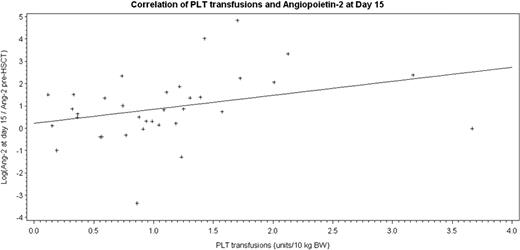Abstract
Abstract 3487
Hematopoietic stem cell transplantation (HSCT) is associated with poor response to platelet (PLT) transfusions. It has been posited that vascular endothelial cell (EC) damage from the effects of high dose chemoradiotherapy is responsible for PLT consumption. To test this hypothesis, we assessed the relationship between serial levels of plasma markers of vascular damage and repair, and PLT transfusion requirement. Plasma samples were obtained on 40 adult and pediatric recipients of allogeneic HSCT with myeolablative conditioning for leukemia, lymphoma, or myelodysplastic syndrome at days -10, +5, +15, and +30. Single donor apheresis PLT transfusions were given prophylactically for PLT count <10,000/mcL or as needed for hemorrhage. To minimize the influence of the rate of engraftment only transfusions through day +15 were considered. The number of transfused PLT units divided by patient's body weight (BW) was recorded. For patients with BW >125% of ideal BW, adjusted BW was calculated as 0.25 × (actual – ideal BW) + ideal BW. The influence of response to PLT transfusions prior to transplant admission was considered. Poor response to PLT transfusion was defined as a PLT count rise of <30,000/mcL on the last PLT transfusion prior to HSCT; individuals with poor response to PLT transfusions prior to HSCT were not excluded. Plasma levels of angiopoietin-2 (Ang-2), platelet-derived growth factor-BB (PDGF-BB), soluble Platelet Endothelial Cell Adhesion Molecule (sPECAM), and vascular endothelial growth factor (VEGF) at each time point were measured using a multiplex ELISA, and the ratio of each biomarker level at days +5 +15, and +30 to the baseline level (day -10 pre-HSCT) was calculated. The ratios of the biomarker level at each time point to baseline were compared by 1-way ANOVA. The relationship of cumulative PLT transfusions at day +15 to the logarithm of each biomarker ratio was assessed by Pearson's correlation coefficient. Simple linear regression was used to assess the relationships of age, gender, total body irradiation (TBI), donor matching, stem cell source, hemorrhage, hepatic veno-occlusive disease (VOD), and prior response to PLTs with cumulative PLT transfusions, and significant variables were introduced into multivariable analysis to assess the relationship of significant biomarker ratios to PLT transfusions. Four patients were excluded from analysis, 1 for death at day +13 and 3 for insufficient samples. The median age was 17.0 years (range 6.7–55.4 years). Nine patients received HLA matched related donor transplants and 31 received alternative donor transplants. TBI was used as part of conditioning in 20 patients, VOD developed in 5, and hemorrhage occurred in 13. The mean number of platelet transfusions from days -10 – 15 was 1.1 units/10 kg BW (range 0.12–3.7 units/10 kg). Ten patients had poor responses to PLT prior to HSCT, 21 had good responses to PLT, and 5 had insufficient data regarding PLT response. Significant reductions were observed in sPECAM-1 at day 5 (mean ratio 0.58 of baseline, range 0.29–1.05, p<0.0001) and in PDGF-BB (mean ratio 0.59 of baseline, range 0.03–2.44, p=0.0198). VEGF was mildly increased over baseline at day 5 (mean ratio 1.49 of baseline, range 0.29–8.4, p=0.048). Ang-2 level was increased over baseline at days 5 and 15, peaking at 8.8-times greater than baseline on day 15 (p=0.075). The log of (Ang-2 day 15/Ang-2 baseline) had a significant positive correlation with cumulative PLT transfusions at day 15 (r2=0.32, p=0.05) (Figure). In simple linear regression, PLT transfusion at day 15 also was associated with hemorrhage (p=0.008) and VOD (p=0.083). Poor PLT response prior to HSCT was not associated with cumulative PLT transfusions at day 15 (p=0.47). In multiple linear regression controlling for hemorrhage and VOD, the association of log(Ang-2 day 15/Ang-2 baseline) with cumulative PLT transfusions remained significant (p=0.024). In conclusion, significant decreases in plasma levels of the vascular adhesion molecule sPECAM-1 and angiogenic growth factor PDGF-BB are seen at day +5 in HSCT. There was wide variation in Ang-2 levels; however increased Ang-2 at day +15 was associated with increased cumulative PLT transfusions at day +15, suggesting that vascular regeneration is associated with increased PLT consumption.
Ofori-Acquah:Emory University: Patents & Royalties.
Author notes
Asterisk with author names denotes non-ASH members.


This feature is available to Subscribers Only
Sign In or Create an Account Close Modal